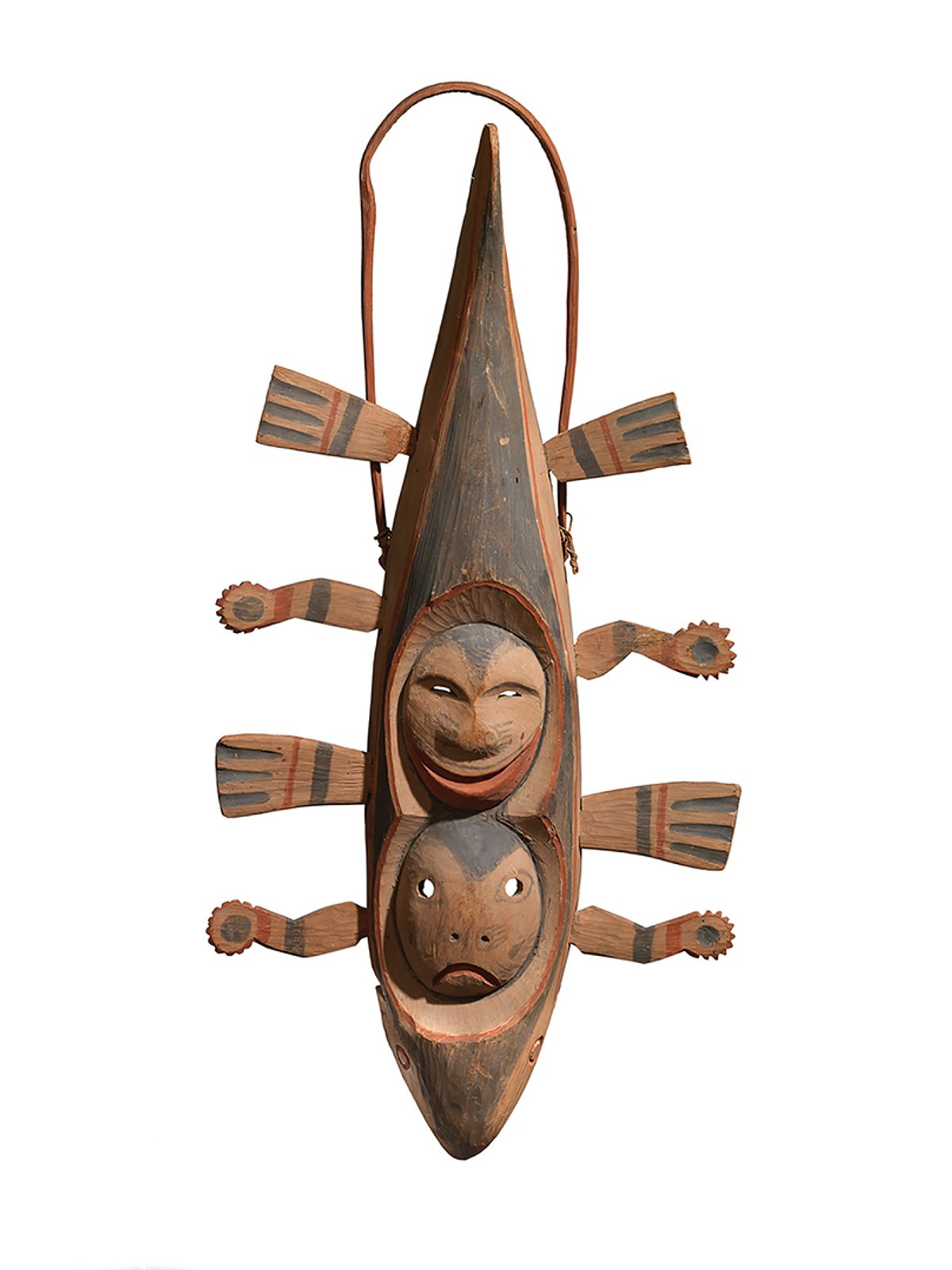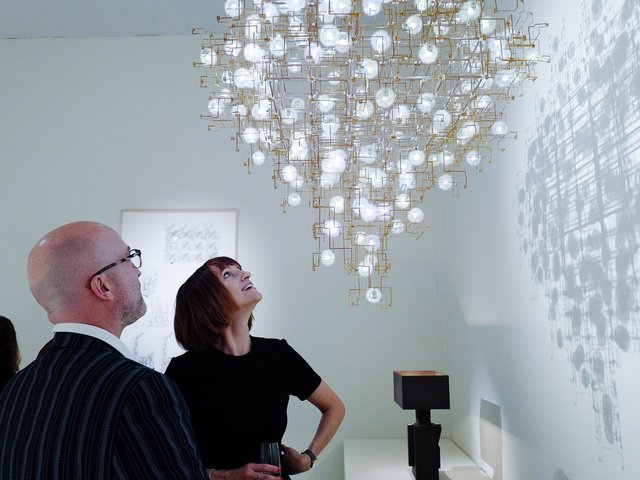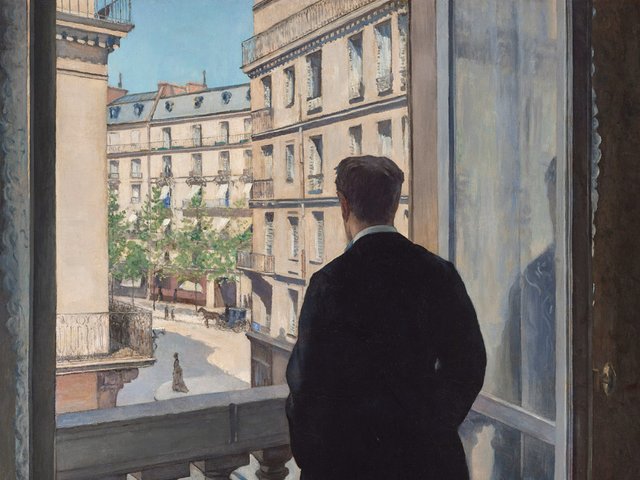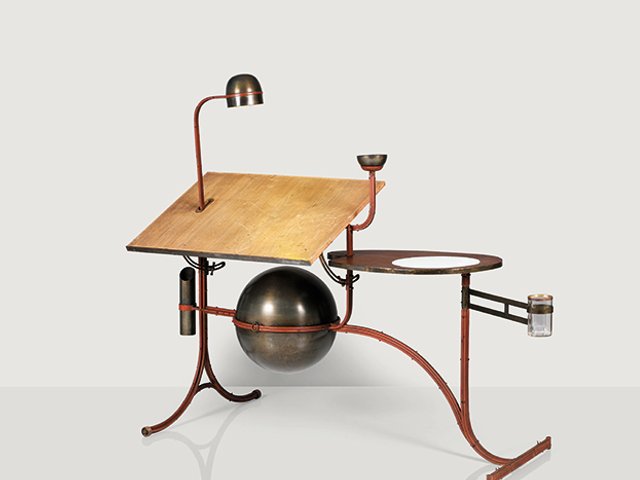Complex Dance Mask (around 1890-1910)
Yup’ik, likely Goodnews Bay, Alaska, $450,000, Donald Ellis Gallery
The Yup’ik is a group of Indigenous peoples of western Alaska and the Russian Far East. A Yup’ik mask such as this one would have been worn during dance ceremonies and presents the artist’s vision of the universe. The masks and performances depict relationships among humans, animals and the spirit world. This wooden piece appears to be in the form of a fish with fins and flippers down the side, while the two faces on the front could represent a seal and some form of land mammal. According to a gallery statement, the top of the mask features a single willow-root hoop, or ellanguaq, “which places the mask within the known universe”.
This work was obtained in Alaska by Joseph E. Chilberg in the late 19th century, according to Donald Ellis Gallery. Chilberg travelled there during the Gold Rush and, over a period of around 20 years, amassed a large collection of Yup’ik objects. In 1917, he established Chilberg’s Alaska Museum of Arctic Antiquity and Curio Emporium in Long Beach, California, which remained in operation until 1935. This mask was later owned by the Surrealist artist Roberto Matta. “Collecting non-Western art formed an important aspect of Surrealist practice, and the present mask is one of the finest examples of its kind extant,” says Donald Ellis, the gallery’s founder.

Rufino Tamayo’s Claustrofobia (1954)
Courtesy Leon Tovar Gallery
Rufino Tamayo, Claustrofobia (1954)
$2.5m-$3m, Leon Tovar Gallery
The Mexican artist Rufino Tamayo rose to international fame in the late 1950s for works that combine European Modernism and Mexican folk art. Like many artists of the time, his work reflected the trauma of the Second World War. A classic example of the Surrealist style, Claustrofobia is a mysterious, dreamlike composition. Part-figurative, part-abstract, the painting seems to show one or two figures pushing against the edge of the canvas, trapped within a room. In the background is a slit of blue that could be perceived as a window. “[It] adds a layer of intrigue and mystery to the composition. It symbolises the artist's exploration of the unknown, be it the unknown world beyond the confined space or the enigmatic realms of the subconscious,” according to a gallery statement.
The work was acquired by its present owner at Christie’s in Paris in 2004 for €969,950 (with fees), just over its higher estimate of €800,000. Leon Tovar Gallery, which displayed the work in the 2023 show 80 Years of Latin American Abstraction in New York, describes the painting as “a Surrealistic masterpiece that captivates with its vibrant colours, enigmatic composition, and skilful depiction of space and movement”.

François-Xavier Lalanne’s Oiseau de jardin à bascule (rocking garden bird) (1974)
Aurélien Mole © François-Xavier Lalanne, Courtesy Galerie Mitterrand
François-Xavier Lalanne, Oiseau de jardin à bascule (rocking garden bird) (1974)
€5m-€6m, Galerie Mitterrand
Spring has sprung, and Galerie Mitterrand’s seasonal offering is this rocking chair in the form of a chirpy little bird by the beloved French sculptor François-Xavier Lalanne. The piece is emblematic of Lalanne’s animal-inspired works, which he often created in partnership with his wife, Claude, known together as Les Lalanne. Oiseau de jardin à bascule is made up of metal plates cut and welded by Lalanne himself, a technique he often used in the 1960s and 70s. While many such works are created from bronze, this seat is made of steel and copper. “The combination of these two materials, with their brown and silver tones, is naturally reminiscent of the bird's plumage,” according to a statement from gallery founder Jean-Gabriel Mitterrand and director Sébastien Carvalho, adding that “it’s swinging movement itself [becomes] a metaphor for the hopping of a pecking bird”.
Lalanne created two versions of his bird rocking chair. This one was acquired in 1974 by a collector in Belgium and was first exhibited in the show Les Lalanne: Domesticated Beasts & Other Creatures at London’s Whitechapel Art Gallery in 1976.
The market for works by Les Lalanne is very strong. In October last year, François-Xavier’s Rhinocrétaire I (1964)—a rhinoceros-shaped piece with a hidden desk, safe and bar that was made in brass using the same method of welding metal sheets—sold at Christie’s in Paris for €18.3m (with fees).
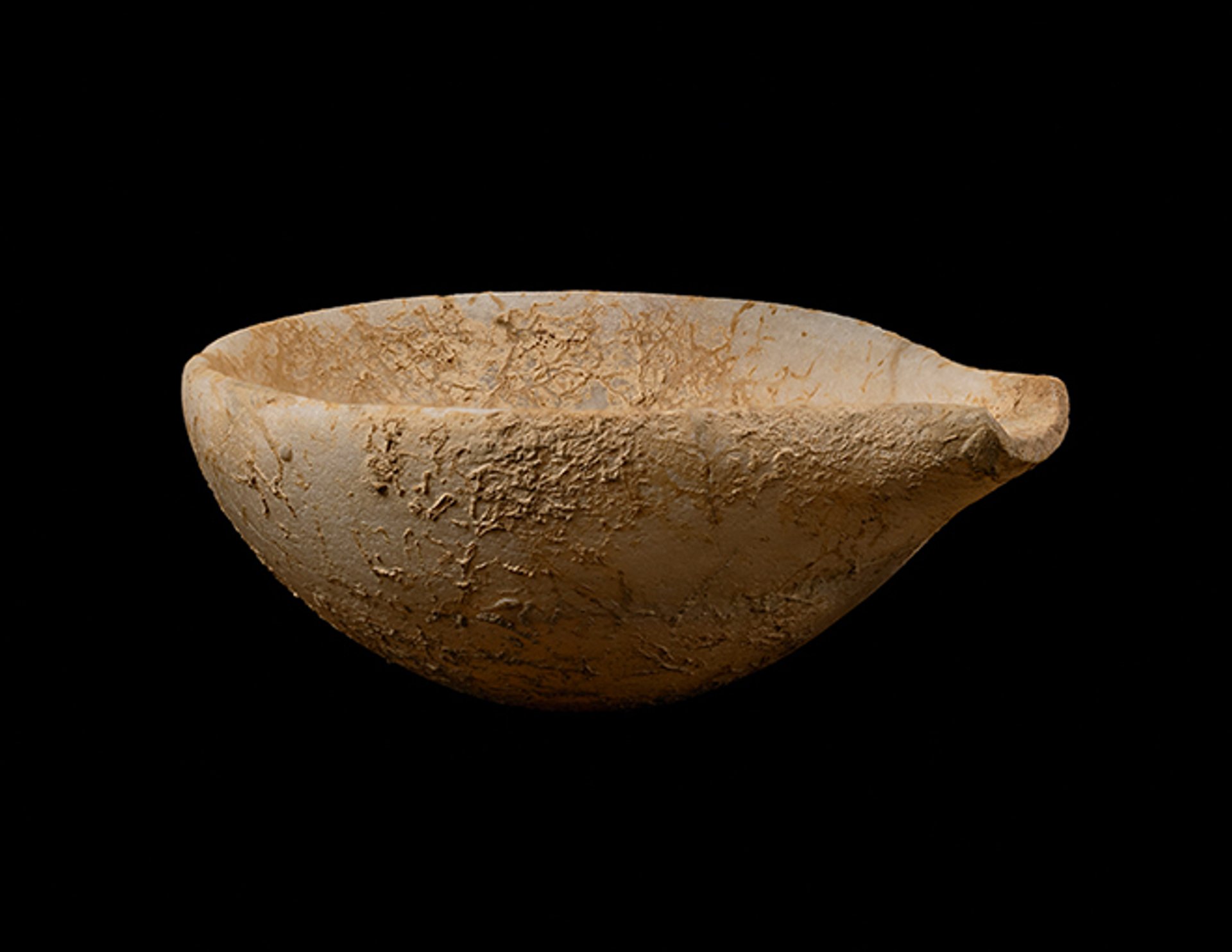
Spouted bowl, Cycladic Greek (around 2,500BC-2,700BC)
Courtesy Ariadne
Spouted bowl (around 2,500BC-2,700BC)
Greek, Cycladic, $28,000, Ariadne
This marble spouted bowl is small but mighty. Measuring just 11cm long and 4cm high, it is almost 5,000 years old. The vessel was probably made for the ritual use of precious paints and oils and was designed to be held with one hand. Gregory Demirjian, the co-owner of London's Ariadne gallery, calls it “a truly magical object” that is “sensitively carved and wonderfully preserved", adding: "It retains burial root marks and traces of ancient pigments." Similar examples can be found in the collections of the Metropolitan Museum of Art in New York and the Museum of Cycladic Art in Athens. The provenance goes back to the Geneva- and Paris-based antiquities dealer Nicolas Koutoulakis, who had acquired it by 1976. It was sold at Christie's in London in 2019, in the same lot as another similar bowl, for £8,750 (with fees), then sold again as a single lot at Christie's in New York in 2023 for $9,450 (with fees).
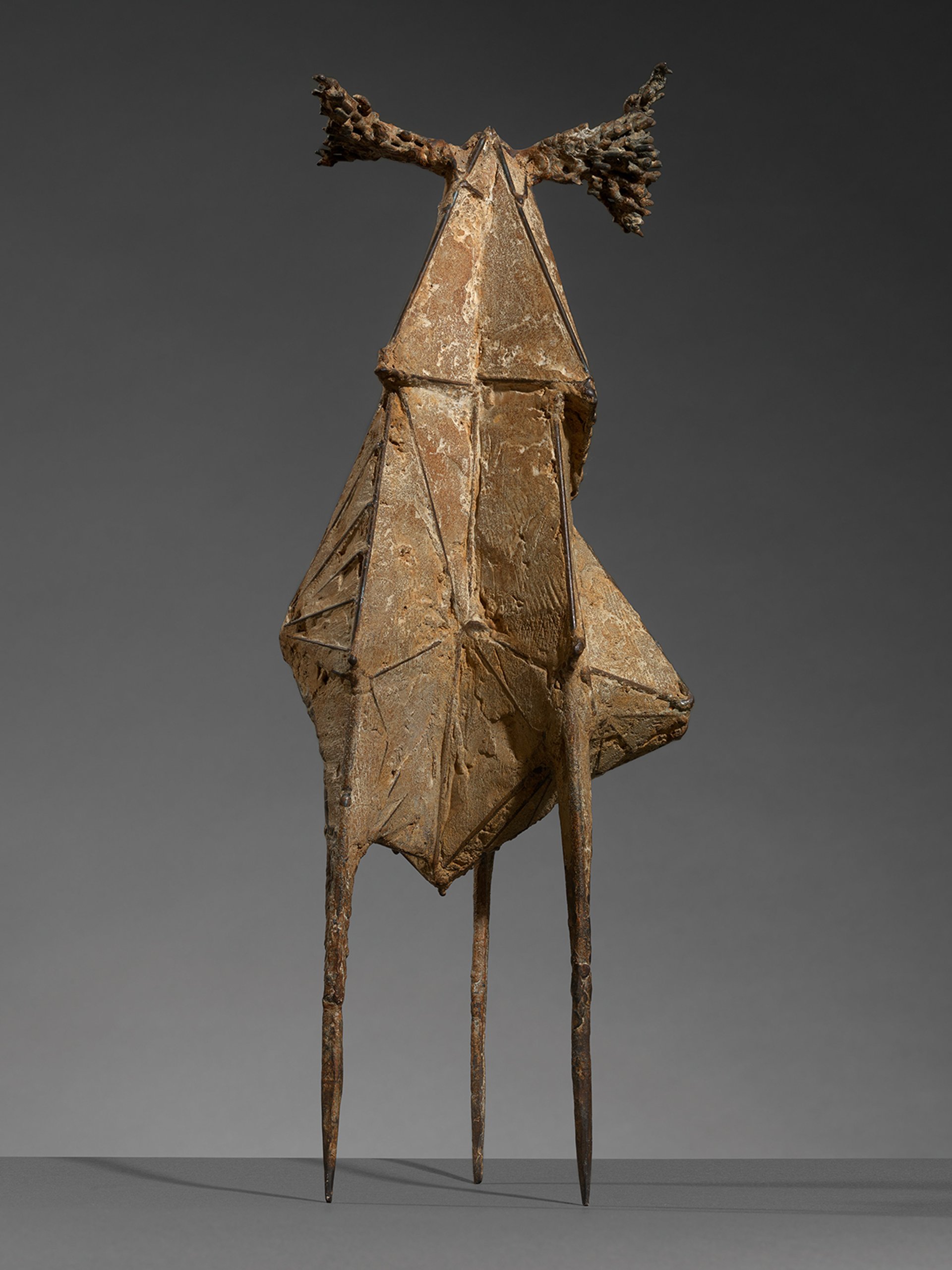
Lynn Chadwick’s Beast (Old Leather Head) (1958)
Todd White Art Photography, Courtesy Osborne Samuel
Lynn Chadwick, Beast (Old Leather Head) (1958)
Under $300,000, Osborne Samuel
The artist Lynn Chadwick came to international fame in 1952 when he was chosen as one of 11 artists to represent Great Britain at the Venice Biennale in a show titled New Aspects of British Sculpture. (One of the works he exhibited there now resides in the collection of the Museum of Modern Art in New York.) However, it was only in 1950 that Chadwick, who trained as an architect, learned to weld and began creating sculptures made of angular frames of iron rods. His early works, such as Beast (Old Leather Head), were created using a unique method of applying a plaster and iron compound called Stolit to his welded armatures. Once dry, the Stolit set rock hard.
Chadwick’s sculptures were often inspired by human and animal forms that veered toward abstraction. “These early strange and sometimes disconcerting, almost supernatural forms, beasts and half humans with distorted limbs, potent with energy and tension, identified Chadwick in the 1950s as one of the most important of all the post-war generation of sculptors, not just in the UK but worldwide,” says Peter Osborne, the owner and director of Osborne Samuel gallery, which has exhibited Chadwick’s work for more than 40 years.


